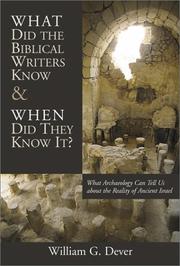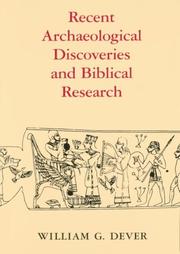| Listing 1 - 10 of 47 | << page >> |
Sort by
|
Book
ISBN: 9780802867018 0802867014 Year: 2012 Publisher: Grand Rapids: Eerdmans,
Abstract | Keywords | Export | Availability | Bookmark
 Loading...
Loading...Choose an application
- Reference Manager
- EndNote
- RefWorks (Direct export to RefWorks)
Archeology --- Bible --- Jewish religion --- Antiquity --- Jews --- Community life --- Religion and culture --- Cities and towns --- Social life and customs --- History --- Bible. --- Antiquities. --- Palestine --- -Community life --- -Religion and culture --- -Cities and towns --- -902 <33> --- 933 --- Global cities --- Municipalities --- Towns --- Urban areas --- Urban systems --- Human settlements --- Sociology, Urban --- Culture and religion --- Culture --- Associations, institutions, etc. --- Human ecology --- Hebrews --- Israelites --- Jewish people --- Jewry --- Judaic people --- Judaists --- Ethnology --- Religious adherents --- Semites --- Judaism --- -History --- -Archeologie--Oud-Palestina. Judea --- Geschiedenis van Palestina en het Joodse volk --- Antico Testamento --- Hebrew Bible --- Hebrew Scriptures --- Kitve-ḳodesh --- Miḳra --- Old Testament --- Palaia Diathēkē --- Pentateuch, Prophets, and Hagiographa --- Sean-Tiomna --- Stary Testament --- Tanakh --- Tawrāt --- Torah, Neviʼim, Ketuvim --- Torah, Neviʼim u-Khetuvim --- Velho Testamento --- -Holy Land --- -Jews --- -Social life and customs --- 933 Geschiedenis van Palestina en het Joodse volk --- 902 <33> Archeologie--Oud-Palestina. Judea --- Archeologie--Oud-Palestina. Judea --- -Archeology --- 902 <33> --- Jews - Social life and customs - To 70 A.D. --- Community life - Palestine - History - To 70 A.D. --- Religion and culture - Palestine - History - To 70 A.D.. --- Cities and towns - Palestine. --- Palestine - Social life and customs - To 70 A.D.
Book
ISBN: 0788500996 9780788500992 Year: 1995 Volume: 52 Publisher: [Lieu de publication inconnu]: American schools of Oriental research,
Abstract | Keywords | Export | Availability | Bookmark
 Loading...
Loading...Choose an application
- Reference Manager
- EndNote
- RefWorks (Direct export to RefWorks)
Excavations (Archaeology) --- Middle East --- Antiquities --- 902 <33> --- 902 <32> --- 902 <392> --- Archeologie--Oud-Palestina. Judea --- Archeologie--Oud-Egypte --- Archeologie--Westelijk Klein-Azië: Troje; Mysië; Frygië; Pergamon; Lydië; Smyrna; Efese; Halicarnassus; Milete; Bithynië; Pisidië; Pamfylië --- 902 <392> Archeologie--Westelijk Klein-Azië: Troje; Mysië; Frygië; Pergamon; Lydië; Smyrna; Efese; Halicarnassus; Milete; Bithynië; Pisidië; Pamfylië --- 902 <32> Archeologie--Oud-Egypte --- 902 <33> Archeologie--Oud-Palestina. Judea --- Antiquities. --- Excavations (Archaeology) - Middle East --- Middle East - Antiquities
Book
ISBN: 1555409261 9781555409265 Year: 1994 Volume: 51 Publisher: [Lieu de publication inconnu]: American schools of Oriental research,
Abstract | Keywords | Export | Availability | Bookmark
 Loading...
Loading...Choose an application
- Reference Manager
- EndNote
- RefWorks (Direct export to RefWorks)
Excavations (Archaeology) --- -Middle East --- Antiquities. --- Middle East --- Antiquities --- Excavations (Archaeology) - Middle East. --- Excavations (Archaeology) - Middle East --- Middle East - Antiquities
Book
ISBN: 9780802863942 0802863949 Year: 2008 Publisher: Grand Rapids: Eerdmans,
Abstract | Keywords | Export | Availability | Bookmark
 Loading...
Loading...Choose an application
- Reference Manager
- EndNote
- RefWorks (Direct export to RefWorks)
Archeology --- Bible --- Jewish religion --- Antiquity --- Asherah (Semitic deity) --- Jews --- Excavations (Archaeology) --- Folklore. --- Israel --- Religion. --- Antiquities. --- Jews - Folklore. --- Excavations (Archaeology) - Israel. --- Israel - Religion. --- Israel - Antiquities.

ISBN: 080282126X 080282126X 9780802821263 Year: 2012 Publisher: Grand Rapids: Eerdmans,
Abstract | Keywords | Export | Availability | Bookmark
 Loading...
Loading...Choose an application
- Reference Manager
- EndNote
- RefWorks (Direct export to RefWorks)
Jews --- Juifs --- History --- Histoire --- Bible. --- History of Biblical events. --- Antiquities. --- Historiography. --- Jews - History - 1200-953 B.C. --- Jews - History - 953-586 B.C.

ISBN: 0295801026 9780295801025 0295965886 9780295972619 Year: 1990 Publisher: Seattle University of Washington Press
Abstract | Keywords | Export | Availability | Bookmark
 Loading...
Loading...Choose an application
- Reference Manager
- EndNote
- RefWorks (Direct export to RefWorks)
Archaeology and Bible--two simple terms, often used together, understood by everybody. But are they understood properly? If so, why are both subject to such controversy? And what can archaeology contribute to our understanding of the Bible? These are the problems addressed by Professor Dever in this book.Dever first looks at the nature and recent development of both archaeology and Biblical studies, and then lays the groundwork for a new a productive relationship between these two disciplines. His “case studies” are three eras in Israelite history: the period of settlement in Canaan, the period of the United Monarchy, and the period of religious development, chiefly during the Divided Monarchy. In each case Dever explores by means of recent discoveries what archaeology, couples with textual study, can contribute to the illumination of the life and times of ancient Israel.Given the flood of new information that has come from recent archaeological discoveries, Dever has chosen to draw evidence largely from excavations and surveys done in Israel in the last ten years--many still unpublished--concerning archaeology and the Old Testament.Dever’s work not only brings the reader up to date on recent archaeological discoveries as they pertain to the Hebrew Bible, but indeed goes further in offering an original interpretation of the relationship between the study of the Bible and the uncovering of the material culture of the ancient Near East. Extensive notes, plus the use of much new and/or unpublished data, will make the volume useful to graduate students and professors in the fields of Biblical studies and Syro-Palestinian archaeology, and the seminarians, pastors, rabbis, and others. This book provides stimulating, provocative, and often controversial reading as well as a compendium of valuable insights and marginalia that symbolizes the state of the art of Biblical archaeology today.
Excavations (Archaeology) --- Bible. --- Antico Testamento --- Hebrew Bible --- Hebrew Scriptures --- Kitve-ḳodesh --- Miḳra --- Old Testament --- Palaia Diathēkē --- Pentateuch, Prophets, and Hagiographa --- Sean-Tiomna --- Stary Testament --- Tanakh --- Tawrāt --- Torah, Neviʼim, Ketuvim --- Torah, Neviʼim u-Khetuvim --- Velho Testamento --- Antiquities. --- Palestine --- Bible. Old Testament --- Antiquities
Book
ISBN: 9780884142171 0884142175 0884142183 9780884142188 Year: 2017 Publisher: Atlanta
Abstract | Keywords | Export | Availability | Bookmark
 Loading...
Loading...Choose an application
- Reference Manager
- EndNote
- RefWorks (Direct export to RefWorks)
William G. Dever offers a welcome perspective on ancient Israel and Judah that prioritizes the archaeological remains to render history as it was--not as the biblical writers argue it should have been. Drawing from the most recent archaeological data as interpreted from a nontheological point of view and supplementing that data with biblical material only when it converges with the archaeological record, Dever analyzes all the evidence at hand to provide a new history of ancient Israel and Judah that is accessible to all interested readers
Excavations (Archaeology) --- Jews --- History --- Bible. --- Antico Testamento --- Hebrew Bible --- Hebrew Scriptures --- Kitve-ḳodesh --- Miḳra --- Old Testament --- Palaia Diathēkē --- Pentateuch, Prophets, and Hagiographa --- Sean-Tiomna --- Stary Testament --- Tanakh --- Tawrāt --- Torah, Neviʼim, Ketuvim --- Torah, Neviʼim u-Khetuvim --- Velho Testamento --- Antiquities. --- Israel --- Palestine --- Excavations (Archaeology) - Israel. --- Jews - History - 1200-953 B.C. --- Jews - History - 953-586 B.C. --- Israel - Antiquities. --- Palestine - Antiquities. --- Palestine - History - To 70 A.D.
Book
ISBN: 9004370153 1575069474 Year: 2014 Publisher: Winona Lake, Indiana : Eisenbrauns,
Abstract | Keywords | Export | Availability | Bookmark
 Loading...
Loading...Choose an application
- Reference Manager
- EndNote
- RefWorks (Direct export to RefWorks)
This volume is the final report of excavations carried out in the Hebron hills and the Negev desert in 1967-1980 on behalf of Hebrew Union College in Jerusalem and the University of Arizona. They were pioneering, multidisciplinary projects that helped to illuminate what was then a poorly known “Dark Age” in the cultural history of ancient Palestine, a nonurban interlude of pastoral nomadic movements over several centuries (ca. 2400–2000 B.C.E.) between the great urban civilizations of the early Bronze Ages. Eighteen appendixes by specialists in many disciplines analyze all aspects of material culture and human and animal remains. A history of previous scholarship and a synthesis of the EB IV period in both Israel and Jordan conclude the volume, which will be a landmark study for many years.
Excavations (Archaeology) --- Bronze age --- Antiquities. --- Bronze age. --- Archaeological digs --- Archaeological excavations --- Digs (Archaeology) --- Excavation sites (Archaeology) --- Ruins --- Sites, Excavation (Archaeology) --- Archaeology --- Civilization --- Archaeological specimens --- Artefacts (Antiquities) --- Artifacts (Antiquities) --- Specimens, Archaeological --- Material culture --- Jebel Qa'aqir Site (Israel) --- Israel --- Israel. --- Dawlat Isrāʼīl --- Država Izrael --- Dzi͡arz͡hava Izrailʹ --- Gosudarstvo Izrailʹ --- I-se-lieh --- Israele --- Isrāʼīl --- Isŭrael --- Isuraeru --- Izrael --- Izrailʹ --- Medinat Israel --- Medinat Yiśraʼel --- Stát Izrael --- State of Israel --- Yiselie --- Yiśraʼel --- Middle East --- Antiquities
Book
ISBN: 080287763X 1467459496 9780802877635 Year: 2020 Publisher: Grand Rapids, Michigan: William B. Eerdmans ,
Abstract | Keywords | Export | Availability | Bookmark
 Loading...
Loading...Choose an application
- Reference Manager
- EndNote
- RefWorks (Direct export to RefWorks)
Bringing the Bible and ancient Israel into a new and brighter light.In the last several decades, archaeological evidence has dramatically illuminated ancient Israel. However, instead of proving the truth of the Bible—as an earlier generation had confidently predicted—the new discoveries have forced us to revise much of what was thought to be biblical truth, provoking an urgent question: If the biblical stories are not always true historically, what, if anything, is still salvageable of the Bible’s ethical and moral values ? Has Archaeology Buried the Bible? simplifies these complex issues and summarizes the new, archaeologically attested ancient Israel, period by period (ca. 1200–600 BCE). But it also explores in detail how a modern, critical reader of the Bible can still find relevant truths by which to live.
Palestine --- Middle East
Book
ISBN: 9780884144793 9781628372953 1628372958 0884144798 0884144801 Year: 2020 Publisher: Atlanta: SBL Press,
Abstract | Keywords | Export | Availability | Bookmark
 Loading...
Loading...Choose an application
- Reference Manager
- EndNote
- RefWorks (Direct export to RefWorks)
This autobiography of William G. Dever is unabashedly his story that offers not only candid reflections on his life, but also on the remarkable generation of giants in archaeology in Israel and the evolving history of the fields of biblical and Israeli archaeology. Chapters cover the ups and downs in both his life and career with brutally honesty. His memoir concludes with a postscript on the likely future of biblical archaeology, and an annotated bibliography provides a guide for serious readers who wish to explore some of the scholarly literature to flesh out Dever's narrative.
| Listing 1 - 10 of 47 | << page >> |
Sort by
|

 Search
Search Feedback
Feedback About UniCat
About UniCat  Help
Help News
News